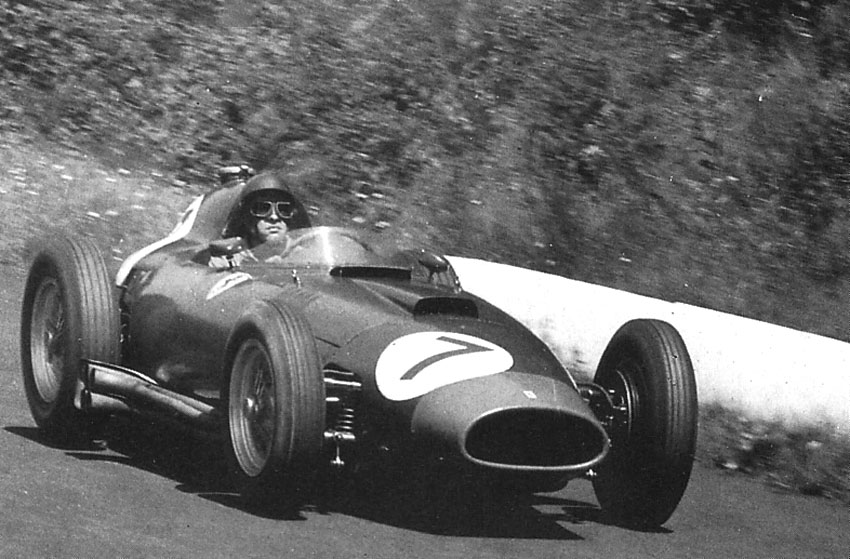


FERRARI 246 DINO
The
birth of the F246 Dino
The
ancestor of Ferrari 246 Dino was the Lancia D50 of
1955 for
Lancia could have been more promising if the silver arrows - nickname given to
the Mercedes - had not been forwarded the same year.
Facing high quality pilots (Moss and Fangio), Lancia could only incline itself.
Juan Manuel Fangio's Mercedes W196 :

This
same year, Ascari (Italian pilot of Lancia) which was world champion in 1952,
went to test a new prototype of Ferrari on
Deeply
touched by its death, and in addition to its financial standing, Lancia sold the
mark to Ferrari.
After
this sale the Dino 246 was born.
Before
the F246 Dino
In 1955,
Ferrari remained only a small label. Two of its models ran this year; the F555
and the F625.
Its best result this season was to finish a Grand Prix in 2nd
position following a crazy Grand Prix in
The Ferrari whose finish second driving by Maurice Trintignant :

A
quite poor year for Ferrari.
In
1956,
with the absence of Mercedes (which aimed to win a title then to withdraw itself),
Ferrari made very good results. Over seven races, three are wan and five are
finished in second place.
Juan-Manuel Fangio wins the constructors championship with the new D50
Lancia-Ferrari. Following the purchase of Lancia, a new Ferrari appears, the D50
Ferrari.
One can see his very special characteristic there: specific tanks are outside
the body (but connected to the frame).
Fangio drives the Lancia-Ferrari D50 at Buenos Aires :

1956 were one conclusive season even if Ferrari remained behind Maserati.
In
1957,
Ferrari still created a new model: the Ferrari 801. Unfortunately it was much
less competitive than the glorious D50. Its best performances was to finish 2nd
three times in
The Peter Collins' Ferrari 801 at the nürburgring :

Ferrari
246D was born: it will be a mix from Ferrari 801 and from this same model in a
Formula 2 version.
One can see its first prototype appearing during the Grand Prix of Morocco 1957
(except championship). It engages cars driven by Collins and Hawthorn. Both will
not finish the race.
In 1958,
Ferrari could align a car which seemed to be their asset. After 3 years
meditating on the question, Ferrari 246 Dino took part for the first time in the
Grand Prix of Argentina and finished second - with Luigi Musso - and third -
with Mike Hawthorn - behind Fangio.
For a first Grand Prix, it’s a success.
Here
are characteristics of this car:
|
Ferrari
246 F1 1958 - Caractéristiques Techniques |
1958
Ferrari 246 F1- Technical Specifications |
||
|
Constructeur |
Ferrari |
Car
maker |
Ferrari |
|
Architecture |
·
Moteur
avant ·
Transmission
aux roues arrières ·
Masse,
560kg à vide |
Architecture |
·
Engine
location, front ·
Drive
type, rear wheels ·
Weight, |
|
Moteur |
·
V6 à 65° ·
Un arbre à cames en tête par banc de
cylindre ·
2 soupapes par cylindre ·
Alésage Course 85
x ·
Cylindrée 2417 cm3 ·
Admission par 3 carburateurs Weber double
corps de ·
Carburant AvGas ·
Lubrification par carter sec ·
280 CV à 8,500 t/mn |
Engine |
·
65° V6 ·
One chain
driven OHC per cylinder bank ·
2 valves
per cylinder ·
Bore & Stroke 85
x ·
Capacity 2,417 cc ·
3
twin-choke downdraught Weber 42 DCN carburettors fuel injection ·
·
Lubrication
by dry sump ·
280 bhp at 8,500 rpm |
|
Transmission |
Boîte de vitesse transversale à 4 rapports + MA
et différentiel à glissement limité |
Gearbox |
4 speed + reverse mounted
transversally in unit with ZF limited-slip differential |
|
Châssis |
·
Structure à deux tubes elliptiques
principaux renforcée par une structure multitubulaire ·
Freins à tambours ventilés de 350
x ·
Roues Borrani de 16" |
Chassis |
·
Composed
of two main elliptic tubes and other small tubes to form a light, rigid
structure ·
Hydraulic drums with helical fins;
F = 350 x ·
Borrani wire spoke 16" |
|
Voies: |
Avant Arrière |
Track: |
48.81" Front 48.81" Rear |
|
Empattement |
|
Wheelbase: |
85.03" |
|
Longueur |
|
Length: |
158.66" |
|
Hauteur: |
|
Height: |
38.58" |
On
transparencies below one can clearly see the side tanks around the pilot,
inspired by Lancia D50.


And
now for Ferrari the 1958 goal is to win the new constructors world championship
and the drivers’ championship.
We will know it thereafter.